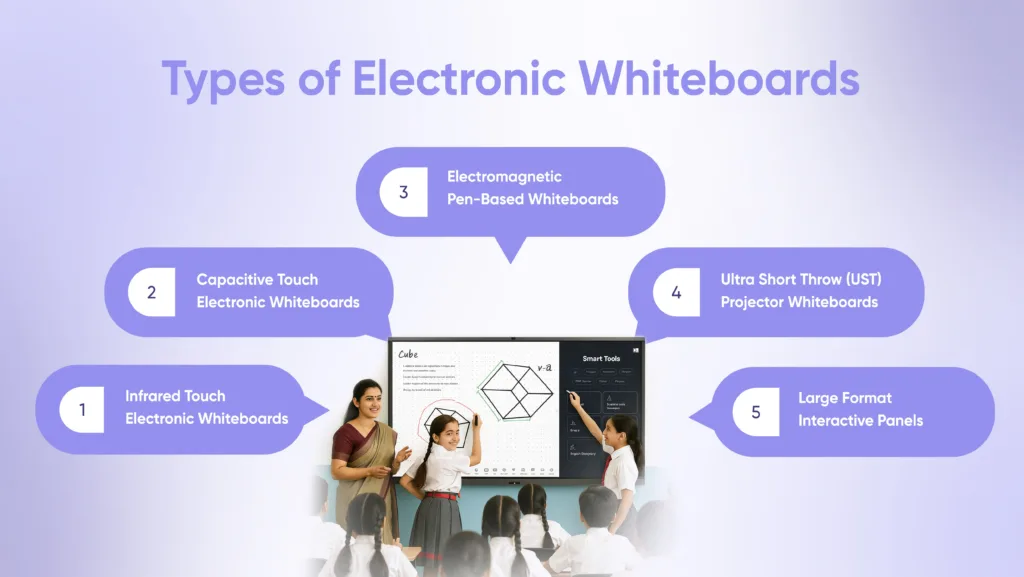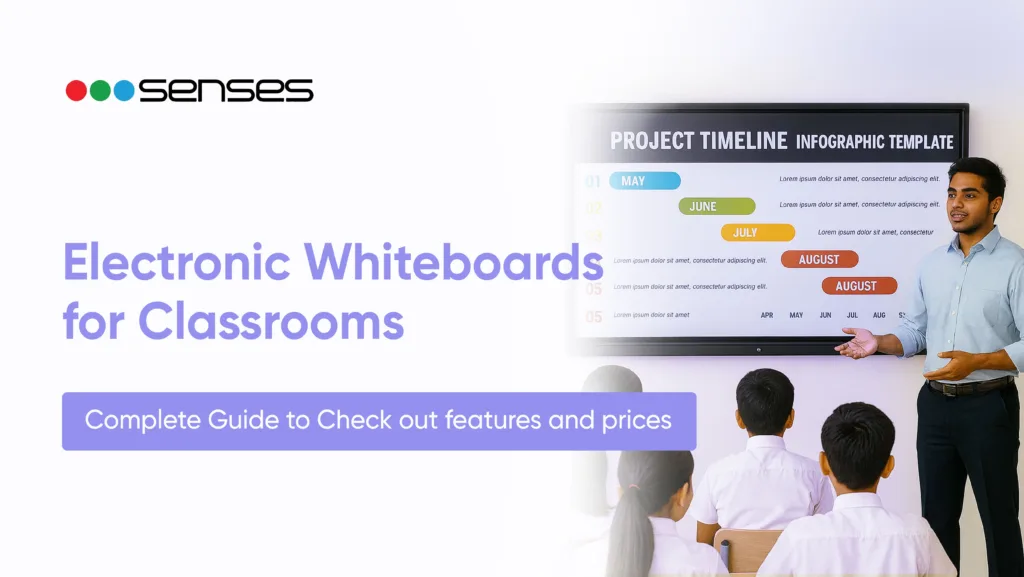Electronic whiteboards, or interactive flat panels, are not simply large digital screens but rather immersive, interactive teaching devices that combine touch-sensitive technology with multimedia and real-time collaborative capabilities.
Senses Electronics has over 70K installations of smart classroom solutions across more than 8k+ venues. Smart electronic whiteboards offer teaching methods that are more interactive and learning methods that are more immersive. Throughout this guide, we will provide you with information that will enable you to locate the best electronic whiteboard for classroom learning.
Key Takeaways:
- Digital whiteboards increase student engagement and make delivering lessons easier.
- The ideal model will depend on the size, features, and cost of the electronic whiteboard.
- The electronic whiteboard range varies from low-cost electronic whiteboards for smaller classrooms to large electronic whiteboards for lecture theatres.
- Senses Electronics can offer solutions that are tailored, cost-effective and reliable.
What is an Electronic Whiteboard?
An electronic whiteboard is a touchscreen display that enables teachers and learners to write, draw, and otherwise interact with digital content. Unlike a traditional whiteboard, those connected to a computer or cloud-based platform can display video and presentations.
Some features of electronic whiteboards that are useful for a classroom student or teacher include:
- Multiple-touches to support collaboration as a group
- Integration into the learning management systems and educational software application
- Higher resolution displays that won’t be difficult to see in bright, well-lit spaces.

Why Choose an Electronic Whiteboard for Teaching?
Interactive electronic whiteboards revolutionize previous lessons, turning straightforward lessons into interactive experiences that can appeal to multiple learning styles and create an experience that is more effective for teaching.
1. Increases Learner Engagement
With a smart electronic whiteboard, students can learn using videos, animated cartoons, and interactive supplementary quizzes to keep learners attending and engaged.
2. Useful for All Subjects
An electronic whiteboard will support STEM subjects, such as having peers become engaged in lessons rather than presenting complex elements for difficult concepts.
It helps for subjects like human anatomy, visualizing a complicated experiment such as photosynthesis in plants, or working through complex math problems.
3. Encourages Collaboration
With multiple students able to use the board, there is never a better option available for an electronic whiteboard for students working collaboratively on a project or within a group activity.
4. Saves Time
Lessons can be prepared, saved, and reused, avoiding needless repeated lesson planning when preparing lessons for new student groups and freeing up additional time for teachers to commit to pupil-centred learning.

Types of Electronic Whiteboards & Technologies
Different styles and technologies exist for electronic whiteboards, and each type serves different classroom-related needs, teaching styles, and budgets. Knowing about these types of electronic whiteboards is very beneficial in figuring out which one or type to choose for your school.
1. Infrared Touch Electronic Whiteboards
Infrared whiteboards involve an infrared light beam around the edges of the whiteboard screen that uses invisible light. When you touch the screen, you break the infrared beam, and the system detects exactly where you touched the screen.
These are inexpensive and durable electronic whiteboards, making them the perfect in-budget electronic whiteboards for primary schools.
Best For: Schools searching for an inexpensive electronic whiteboard that offers good basic multi-touch functionality.
2. Capacitive Touch Electronic Whiteboards
Capacitive touch electronic whiteboards work like those of smartphones and can detect the touch, pressure and even the electrical charge through your finger or stylus. They provide a very smooth and very responsive experience when interacting with the digital whiteboard screen.
Capacitive touch interaction is common between smart electronic whiteboards designed for the advanced classroom.
Best For: Universities and institutes needing wall-mounted electronic whiteboards with high precision in connection with professionally presented content or STEM based education.
3. Electromagnetic Pen-Based Whiteboards
These devices use a special pen specifically constructed with a circuit and communicate with the board itself. This allows for high precision, which is particularly helpful for subjects that require detailed writing or diagrams. Examples include mathematics, engineering or electronic whiteboards (for STEM teaching).
Best For: Technical subjects and collaborative projects where accuracy is an important requirement.
4. Ultra Short Throw (UST) Projector Whiteboards
These combinations utilise a UST projector with a touch-sensitive surface. It sits above the whiteboard eliminating shadows or glare captured by the cameras. They are a cost-effective way to add interactivity to existing surfaces with electronic versions of traditional whiteboards.
Best For: Schools looking for the cheapest alternative to use as an electronic whiteboard while maintaining existing projector space.
5. Large Format Interactive Panels
The best, or high-end, large electronic whiteboards have 4K screen resolutions and multi-touch plus built-in software. These devices are perfect for collaborative projects! Or classrooms that have a requirement for maximum visuals.
Best For: Institutions looking for the best electronic whiteboard for immersive teaching with technology and longevity.
How to Choose the Best Electronic Whiteboard for Your Classroom
When purchasing an electronic whiteboard for your classroom, things to consider include:
1. Size: For lecture halls, you will likely want a large electronic whiteboard (85” and up). And for primary and secondary classroom spaces, smaller sizes (65”–75”) are appropriate.
2. Resolution: 4K resolution gives clear visuals and will be key for an electronic whiteboard for STEM teaching.
3. Touch Points: more touch points means more students who can work together.
4. Software Compatibility: Be sure it works with Google Classroom, MS Teams, and the well-known learning apps.
5. Price & Value: Make sure to check electronic whiteboard price lists so you can get the best features for the money. Remember, the cheapest electronic whiteboard cost isn’t always the best value.

Electronic Whiteboard Price & Cost Analysis
Knowing the different price ranges for electronic whiteboards gives schools a chance to plan their budget. Because size, technology, features, and both brand name and budget all contribute to different costs of electronic whiteboards, a comparison is advised before making a final purchase.
Price Ranges in India (Approx.):
A number of factors, such as size, brand, and feature set, affect how many electronic whiteboards are in Indian classrooms.
| Screen Size | Features | Ideal For | Estimated Cost |
| 65 | Full HD, annotation tools | Regular classrooms | ₹ 155000/piece |
| 75 | 4K, dual OS, smart software | Senior classes, labs | ₹ 190000/piece |
| 86 | Advanced interactivity, audio output | Auditoriums | ₹1,40,000 and ₹3,00,000 |
Factors affecting price:
- Display size and resolution.
- Touch technology.
- Built-in software features.
- Mounting type (portable or wall-mounted electronic whiteboard for universities).
Best Practices for Deploying Electronic Whiteboards in Classrooms
The effective use of your electronic interactive whiteboard to teach in the classroom starts from day one. Following the unit’s best practices can help facilitate the processes involved, ensuring better setup, classroom engagement and overall value for your expense.
1. Provide Quality Teacher Training
Having a top-notch electronic whiteboard will not matter if educators do not know how to maximise its use! Make sure you provide teacher training sessions, allowing educators to explore its features such as touch tools, annotation, saving lesson components, and adding multimedia.
2. Incorporate Into The Curriculum
Avoid displaying presentations and passing them off as worthy; design interactive lessons while utilising the features on the whiteboard. In STEM subjects, educators could utilise 3D diagrams and videos and, therefore, interact with the students and ensure a richer learning experience.
3. Care for and Update The Equipment as Necessary
We must physically care for the surface of the whiteboard and maintain both the hardware and software by software when necessary and continue to seek resolution of smaller technical issues before they become a larger problem. This will ensure longevity and preserve cost efficiency.
4. Promote Student Involvement
Let students solve problems, do some annotation/markup on diagrams, or share projects at the front of the classroom. The interactive electronic whiteboard can then become a learning tool for students, not only a teachers’ resource.
5. Use the Right Accessories
Use good quality styluses, wall mounts, or mobile stands for your whiteboard. If applicable, an external sound system in some cases can enhance the classroom experience.
Case Studies – Senses Electronics in Action
Examples from the real world demonstrate how electronic whiteboards from Senses Electronics are enhancing instruction in classrooms and universities.
| Case Study 1: Delhi Public Senior Secondary School All classrooms at Delhi Public Senior Secondary School have been upgraded by Senses Electronics with the installation of smart electronic whiteboards to replace traditional chalkboards. Challenge: The Teachers saw students were struggling with engagement during theory-heavy subjects like science and maths. Solution: Senses Electronics provided large electronic whiteboards in 4K resolution that include multi-touch. Results: Participation increased by 45% within the first semester.Teachers saved roughly 30 minutes of class time on each lesson using pre-loaded lesson templates. Parents identified improved understanding and recall among their children. |
| Case Study 2: Sunrise Engineering College, Bangalore Sunrise Engineering College wanted to update their lecture theatres for teaching STEM and collaborative projects. Challenge: The lecture theatre’s projectors and whiteboards were outdated and could not be used for interactive learning. Solution: Each lecture theatre had a wall-mounted electronic whiteboard from Senses Electronics, and each electronic whiteboard was integrated into the college’s e-learning platform. Result: Students could easily annotate complex diagrams during the lectures.Group presentations about their projects became engaging and visual.For the faculty, there was a more seamless teaching and learning experience with fewer technical hiccups. |
Why Buy Electronic Whiteboards from Senses Electronics?
If you are looking for the best electronic whiteboards in India, Senses Electronics would be your best choice because:
- They provide affordable electronic whiteboards for teaching (and they do not sacrifice quality).
- It offers touch-enabled electronic whiteboard price lists suitable for any small school or large university.
- They have devices that are excellent for collaborative projects, STEM Labs, and lecture halls.
- You can rely on their after-sales service after you purchase and put your mind to rest.
Conclusion
In educational settings, an electronic whiteboard has passed the point of being anything like a luxury; it has become a necessity for interactive, effective teaching. In the case of small and cheap electronic whiteboards to very large smart electronic whiteboards used at universities, there is a product to fit any price point.
Having a combination of affordability, quality, and decent support, Senses Electronics is one of the best options for schools across India wanting to buy future-ready tools to support their teaching.
FAQs
An electronic whiteboard is a type of digital teaching aid that creates the ability for teachers and students to interact with multimedia content through touch or stylus input.
Yes, a cheap electronic whiteboard will be adequate for primary schools if it meets core teaching needs.
For STEM subjects the best electronic whiteboard would be large (85″), capable of 4K resolution and multiple touch inputs.
Senses Electronics provides high-quality, low-cost and configurable whiteboards with local support.

